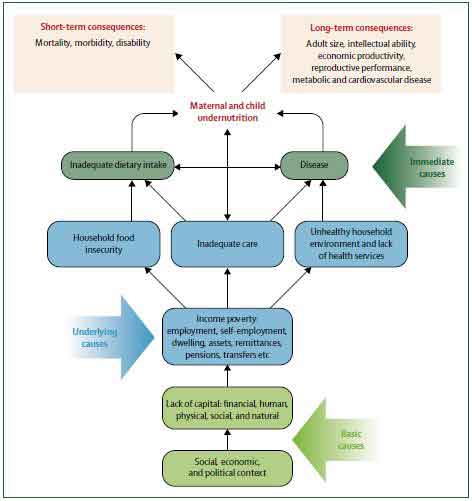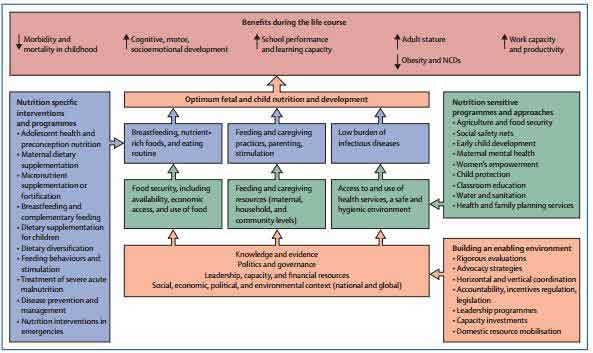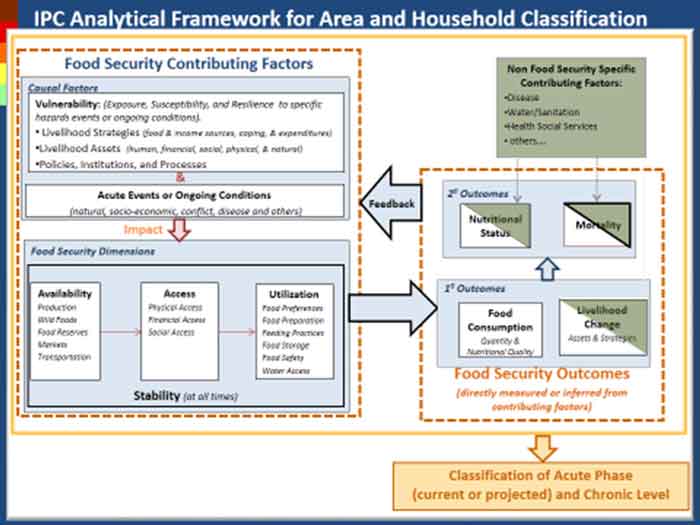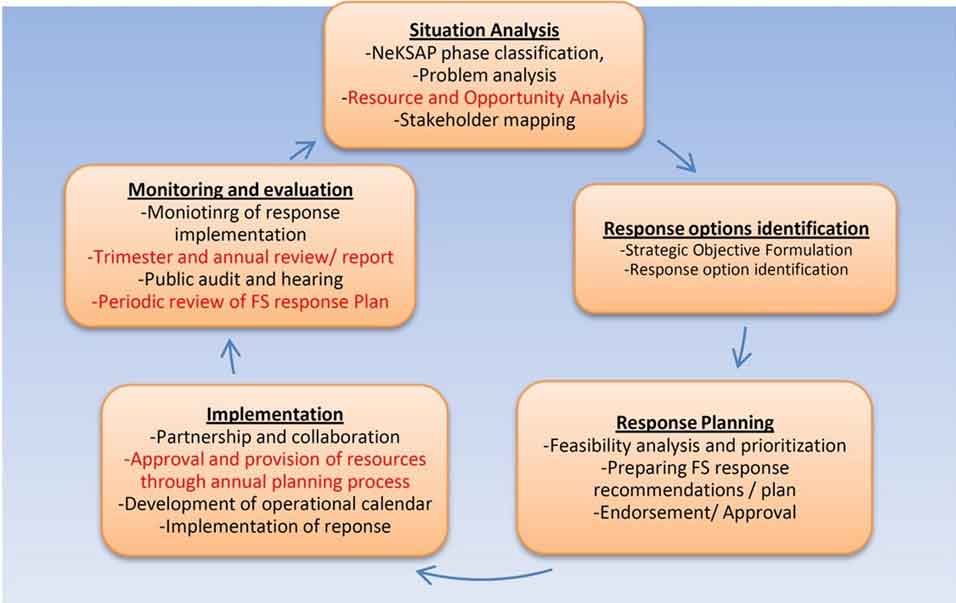This page attempts to elucidate the basic concepts related to nutrition and food security. An understanding of the causes and consequences of poor nutrition and food insecurity as well as the potential solutions based on global evidence and recommendations can be found here.
Nutrition
Figure 1 shows the conceptual framework for understanding the causes of maternal and child undernutrition. This framework was published in the 2008 Lancet Nutrition Series adapted from an original framework developed by UNICEF in 1990. It highlights the short and long term consequences of undernutrition as well as depicts that the causes are interrelated and operate at three different levels. The immediate causes are inadequate dietary intake, a high burden of disease or, an interaction between the two. Similarly, the underlying causes are organised into three groups: household food insecurity; inadequate care and unhealthy household environment and lack of health services. Income poverty is placed as another underlying cause as well as a driver of the other three underlying causes. Underlying causes are the product of a set of basic causes, including the lack of financial, human, physical, social and natural capitals. Yet more basic causes are the social, economic and political contexts that determine the ways in which those potential resources are controlled and managed.
Figure 2 shows a conceptual framework for actions published in the 2013 Lancet Nutrition Series. It outlines the factors that lead to optimum nutrition and development and the resulting benefits throughout the life course. Also depicted are the necessary and proven nutrition specific and nutrition sensitive interventions and approaches.
Undernutrition to a large extent perpetuates itself as an intergenerational cycle carrying on for generation after generation. The vicious cycle is depicted in figure 3 and it must be broken in order to eliminate undernutrition. It is now better understood that the period of growth from conception up to around two years of age provides a critical window of opportunity for ensuring adequate future growth, development, and nutritional status. Hence, the importance of optimal nutrition for women before and during pregnancy cannot be undermined. Taking a life-cycle approach, if sound nutritional status of women is ensured during early childhood, adolescence and adulthood, then the new generation of babies will be born healthy thereby interrupting the intergenerational cycle.
Food Security
“Food security exists when all people, at all times, have physical and economic access to sufficient, safe and nutritious food to meet their dietary needs and food preferences for an active and healthy life.” -World Food Summit (October 1996).
Until the decade of 1970s, food security was understood more generally as the ability of a nation to meet its aggregate food needs in a constant manner. Aggregate food need is calculated by multiplying per capita annual food requirement (200 kg/capita/year) by total population in the country. However, food security is not merely food self-sufficiency. This school of thoughts is dominantly over-ridden by the principle that describes food security as food availability; and, attempt enhancing food availability by increasing food grain production at a higher level than requirements. However, the evidence shows that there are cases of persistent food poverty, malnutrition, and food vulnerability in food self-sufficient and even food surplus areas. There are continuous advances in the understanding and working approaches of food security issue.
In 1974, the World Food Summit identified reliable supply and less fluctuating prices (in addition to sufficient food production) as essential factors for meeting food security. With this food security, being attempted merely by technological means, attracted other factors like market, transport, supply, food price etc. The food security until then was attempted through strengthening factors influencing ‘supply’ aspects. Later Nobel laureate Amartya Sen put forward an alternative view during 1980s, which emphasised the importance of access or entitlements to food in achieving food security. With this the focus on food security tilted towards ‘demand’ aspects instigated to receive attention.
At present, the concept of food security assumes to meet the following conditions: food available at all times; that all persons have means of access to it; that it is nutritionally adequate in terms of quantity, quality and variety; and that it is acceptable within the given culture. Only when all these conditions are in place can a population be considered ‘food secure’. Thus the focus of food security is on four key dimensions (availability, access, utilization and stability), known as the four pillars of food security (figure 4.)
Food availability is the physical presence of food in the area through all forms of domestic production, commercial imports and food aid. Food availability in the area is determined by considering production, trade, stocks and transfers.
Food access is the ability of a household to acquire adequate amounts of food. Food may be available in the market in sufficient quantity and diversity, but this may not necessarily be in the access of people with low income and/or low purchasing power. Food access of individual household is determined by considering food production and stocks, purchases, barter, gifts, borrowing and food aid.
Food utilisation refers to proper use of food. This considers food storage, processing and preparation methods, including the water and cooking fuel used, and hygiene conditions maintained during preparation and consumption. Food utilization also concerns about the conversion of diet into nutrition and its use in body physical functioning. Individual food requirement generally remains different as the food requirement of children, pregnant women and elderly within the household is not same to that of healthy adults. Therefore this also takes account of use of food by individuals in the household according to their nutritional need.
can be achieved once availability, access and utilization of food are ensured at all time and without significant fluctuation in the situation. Stability concerns about the sustainability of the satisfactory achievement of conditions related to all three aspects of food security discussed above.
Key frameworks for food security monitoring, analysis and response design:
Integrated Phase Classification (IPC) Analytical Framework
IPC Analytical Framework is used for food security, nutrition, and livelihoods analysis. This framework provides emphasis on analysing food security at household level. Figure 5 illustrates the key aspects of these frameworks and their inter-linkages.
Nepal Food Security Monitoring System (NeKSAP) Framework
A collaborative effort between Government of Nepal, WFP and FAO have developed a framework for the Food Security Monitoring System in Nepal (Figure 6). The framework is designed to provide basis for analysis of all paradigms (availability, access, utilization and stability) of food security for different purposes (sectoral analysis, generate baseline information, establish surveillance systems, assessment)and at different socio-organisational level (micro, meso and macro level analysis) (Figure 7). The aim of this system is to inform government and development/emergency actors in order to design and implement appropriate and timely policies and actions leading towards a more food secure Nepal.
Food Security Response Analysis (FSRA) framework
The NeKSAP has advanced further from monitoring and analysis and developed a framework for food security response analysis. This framework shown in figure 8 provides the tools and processes for response design integrating the information generated from food security monitoring and analysis.
References
1. Lancet (2008). Maternal and Child Undernutrition Nutrition Series 2008.
2. Lancet (2013). Maternal and Child Undernutrition Nutrition Series 2013.
3. United Nations Standing Committee on Nutrition (UNSCN) (2010.) Maternal Undernutrition and the Intergenerational Cycle of Growth Failure.
4. ADB (2011). Agricultural Development Strategy: Inception Report. Technical Assistance for the Preparation of the Agricultural Development Strategy,Asian
Development Bank. Kathmandu, Nepal.
5. Adhikari J (2010).Food insecurity, conflict and livelihood threats in Nepal. In: Livelihood Insecurity and Social Conflict in Nepal. Bishnu Raj Upreti and Ulrike
Müller-Böker (eds). South Asia Regional Coordination Office, Swiss National Centre of Competence in Research (NCCR) North-South. Kathmandu, Nepal.
6. IPC Global Partners. 2012. Integrated Food Security Phase Classification Technical Manual Version 2.0.Evidence and Standards for Better Food Security Decisions.
FAO. Rome.
7. GoN, WFP and FAO (2010). Framework Document for Institutionalizing National Food Security Monitoring in Nepal. The Government of Nepal (GoN), the UN World
Food Programme (WFP) and the Food and Agriculture Organization (FAO).






